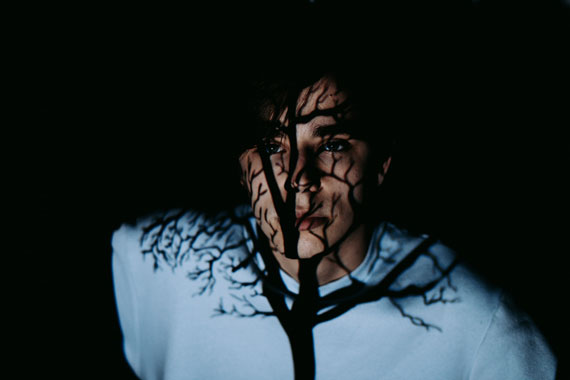The right lighting is key to any shoot, but you can do much more with it than illuminate your subject. Everyday household items are ideal tools to use to bend the light, casting unique shadows on your subject. Gavin Hoey is passionate about teaching photographers everything he knows about the trade. Yes, including how to use “cookies” and artificial light to create eye-catching shadow portraits in-studio!

The Darker, the Better
When working in-studio with artificial lighting, it’s important to control the light. First, you want to close your blinds and any ajar doors. Then, set your camera to its darkest settings to ensure you’re only capturing artificial lighting. In this case, Gavin has his on ISO 200, 1/250s shutter speed, and f/5.6.
However, the ideal settings for your camera may vary based on your kit and unique studio settings. Ideally, take a test shot with no flash to find out whether you’re in the sweet spot. It should be completely dark, with no shadows, light, or subject perceptible to the eye — or a brightened screen.
Artificial Lighting Equipment Is Key
Now, for the lighting equipment. For this tutorial, Gary is using his Flashpoint Xplor 300 Pro TTL monolight. The reason he’s picked it instead of a regular flash light is because it also has a modeling light. So he can see what he’s illuminating prior to photographing it. Its flash tube only goes off when the camera shutter does.
He also has a:
- A Flashpoint eVOLV 200 strobe light on hand for multi-directional lighting.
- To further modify your light, a conical snoot and standard reflector are ideal.
- If you’re shooting solo, then a rack with an adjustable suspension clip is a must, too. You can use it to suspend fabric and whichever items you choose to use as a cookie.
Get Inventive Choosing a Cookie
If you’ve been puzzling over what a “cookie” is up until now, now is the time for the great reveal! Put simply; it’s any item you use to partially block or modify projected light and cast shadows. Preferably something that’s partially transparent while being opaque in other areas.
…and this video has a connection between a garden sieve and some lace fabric. They are both gonna make great cookie’s! And cookie’s are something that cast shadow’s. This video is all about creating the sharpest possible shadows in a small home studio…
Get inventive and rifle around in your drawers, cupboards, and pantry. Think lace fabrics, mesh, sieves, netting, offcuts, grills, slats, decorative carvings — and even kitchen cooking utensils like colanders! Just like a cookie cutter, whatever you choose should “cut” the light into interesting patterns.

Face Shadow idea captured by Marcus Urbenz
Play Around With Light Distance
The distance at which you place your strobe and monolights affects the shadow and light’s sharpness. To create a crisper pattern, move the light further away from your cookie and model. As you do so, your cookie pattern will become sharper and smaller.
You can also leverage light modification tools to create more defintion. For this tutorial, Gavin wants the hardest, crispest light, so a standard reflector is best — or a conical snoot. At further distances, you may even capture the shadows of the finer details and webbing of lace with a snoot!
Just remember, the further away and smaller the light source, the better. A smaller light source concentrates light. In contrast, a larger or broader source, like a softbox, will diffuse shadows and your cookie pattern. Perhaps even rendering them completely imperceptible, especially when the flash pops.
Lastly, do play around with your light settings. For his Xplor monolight, Gavin uses the 1/2 and 1/1 settings. Or a low setting of 1/128 on his eVOLV, which he places just behind his model’s head. You, too, may need a little backlighting to ensure part of your subject doesn’t dissolve entirely into inky blackness.
Conclusion
Light is a key element of photography, but shadow is its counterpart. The two are never apart, yet shadows are often overlooked. However, you can use both to bring out the best in your images — as Gavin illustrated in this insightful shadow portrait tutorial!
Like This Article?
Don't Miss The Next One!
Join over 100,000 photographers of all experience levels who receive our free photography tips and articles to stay current:





